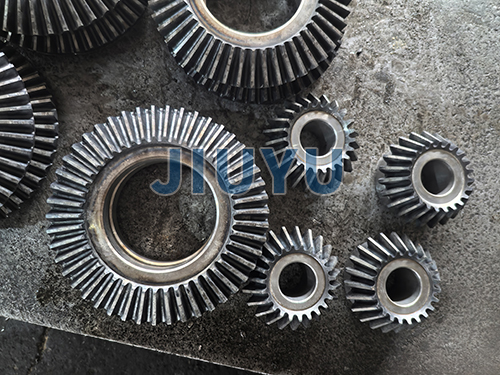
The processing of bevel gears is a relatively complex process.The following is an introduction to common processing methods,technological processes,and processing equipment:
processing
Gear milling:Use milling machines and specialized milling cutters to process bevel gears.This method is suitable for bevel gears with low precision requirements and small batch sizes.Milling can produce various tooth shapes,but the processing efficiency is low and the tooth shape accuracy is relatively poor.
Gear hobbing:Using a gear hobbing machine for machining,cutting the tooth profile through the reciprocating motion of the cutting tool.The precision of gear hobbing is higher than that of milling,and it is suitable for medium precision bevel gear machining.
Hobbing:Hobbing is an effective gear machining method that uses the relative motion between the rolling cutter and the workpiece to cut the tooth profile.Gear hobbing can achieve high tooth profile accuracy and surface quality,making it suitable for mass production of bevel gears.However,special adjustments and process measures are required for the taper and tooth orientation of bevel gears.
Grinding gear machining:Grinding gear is a precision appropriate gear machining method used to machine bevel gears that require high precision.By grinding the tooth surface with a grinding wheel,the deformation after heat treatment can be eliminated,the tooth profile accuracy and surface smoothness can be improved,thereby reducing the noise of gear transmission,improving transmission efficiency and service life.
technological process
Gear blank processing:Firstly,according to the size and material requirements of the bevel gear,the raw materials are processed into gear blanks.This includes forging or casting gear blanks,followed by turning to machine the outer circle,inner hole,end face,and other reference surfaces of the gear,providing accurate positioning references for subsequent gear profile machining.
Tooth profile machining:Based on the precision requirements and production batch of the gear,select the appropriate tooth profile machining method,such as milling,planing,rolling,etc.,for tooth profile cutting.In the process of tooth profile machining,it is necessary to strictly control the parameters of the cutting tool,cutting speed,feed rate and other process parameters to protect the accuracy and quality of the tooth profile.
Heat treatment:After tooth profile machining,it is usually necessary to perform heat treatment on bevel gears to improve their strength,hardness,and performance.Common heat treatment methods include quenching,tempering,carburizing quenching,etc.Heat treatment can enhance the hardness and performance of the gear teeth,while maintaining good toughness in the center,thus meeting the stress requirements of the gear during operation.
Precision machining:After heat treatment,gears may undergo certain deformations and require precision machining to improve their accuracy.Precision machining methods include gear grinding,honing,etc.Grinding teeth can effectively improve tooth profile accuracy and surface quality,while honing teeth is mainly used to improve tooth surface smoothness and reduce tooth surface roughness.
Surface treatment:In order to improve the corrosion resistance(based on actual reports)and performance of bevel gears,it is sometimes necessary to perform surface treatment on the gears,such as hard chrome plating,blackening,phosphating,etc.Surface treatment can form a protective film on the surface of gears,preventing them from being corroded and worn by the external environment,and extending the service life of gears.
Quality inspection:Strict quality inspection is required at every stage of umbrella gear processing.The detection content includes parameters such as tooth profile accuracy,tooth profile accuracy,tooth pitch accuracy,gear runout,and tooth surface roughness.By using specialized testing equipment such as gear measuring instruments and coordinate measuring instruments,various aspects of gear inspection are carried out to confirm that the quality of the gear meets the design requirements.



